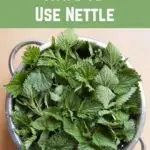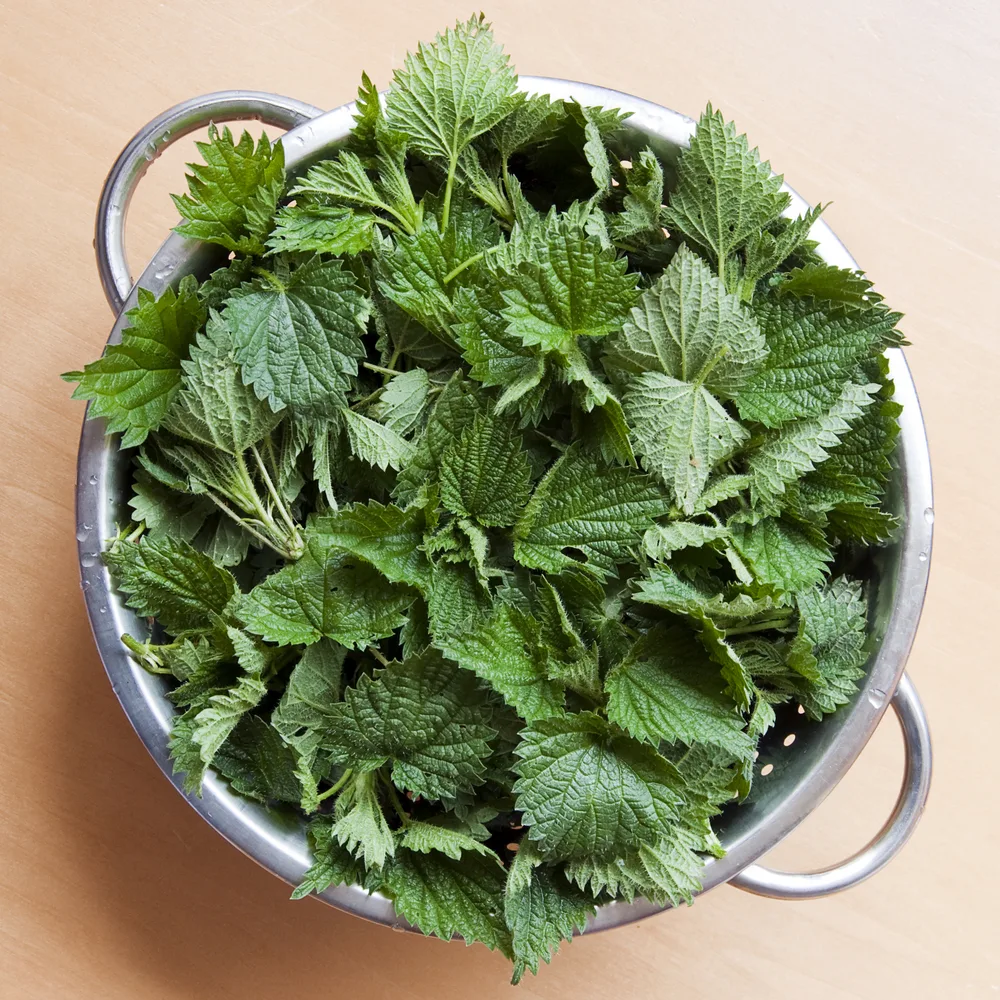
Nettles have long and interesting history dating as far back as the Bronze Age, where they were once used for food, medicine and fiber.
Times have changed greatly since 2500 BC and yet, the perennial nettles are still here, thriving in wild spaces. The question is: do we appreciate them as much as we should?
Perhaps if we relearned to honor the nettle’s beneficial qualities and strengths, we could embrace them once again, very carefully that is.
Remnants of nettle fibers have been found in burial cloth originating from Scandinavia thousands of years ago, but we don’t need to go back quite so far in history to see that nettle is a superior fiber, like flax, worth revisiting.
Closer to date, in the 16th and 17th centuries, nettle fabric was commonly found in Scottish linens. And in World War I, Germans facing a textile shortage found that nettles were an excellent substitute to cotton.
In comparison to cotton, nettle is far stronger, making it suitable even for weaving fishing nets, sailcloth and cordage. Nettle can also be used in the production of paper and stinging nettle beer.
Intrigued? Now you must get out foraging and find some nettles for yourself!
Where to find stinging nettle (Urtica dioica)
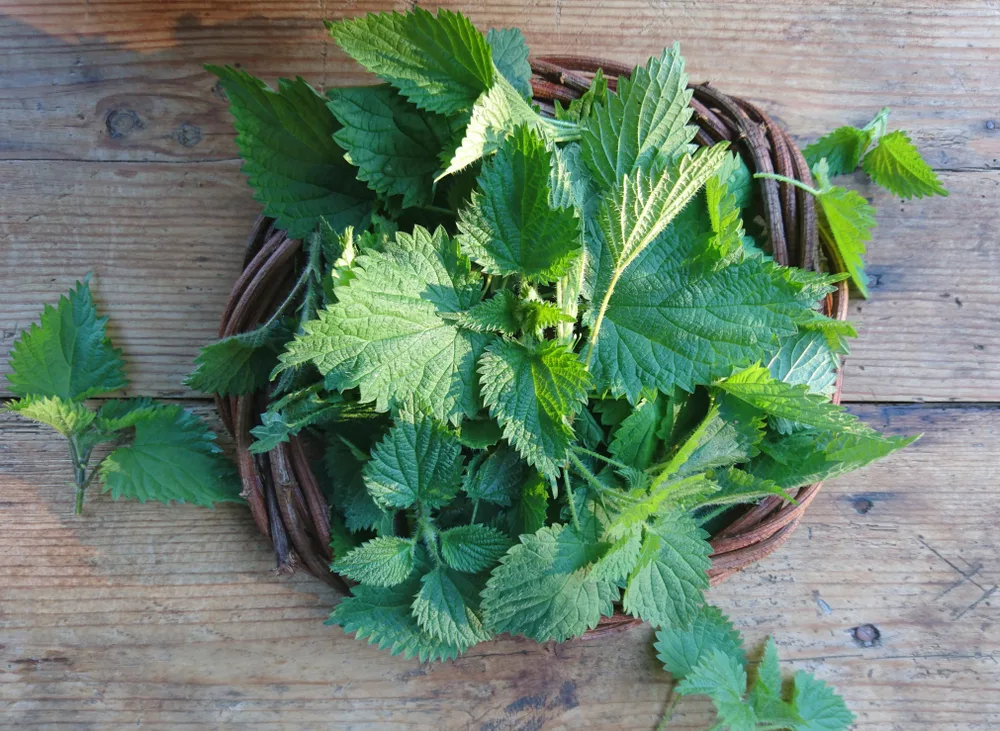
Stinging nettle capsules can be bought from health food stores, though fresh is still the best. In this way, you can use them as a spring vegetable, not just a powder, providing you with limitless options for making omelettes, scrambles, quiches, soups and pesto.
You will always find stinging nettle growing in temperate climates and in nutrient-rich soils. Often growing on top of compost or old branch piles full of decaying organic matter.
As far as sunlight is concerned, nettles thrive along edges, meaning that they are both sun loving and shade tolerant.
If they don’t grow naturally in your backyard, you can transplant the rhizomes and enjoy them year after year, as they are tough, perennial plants.
Recognizing them is simple enough.
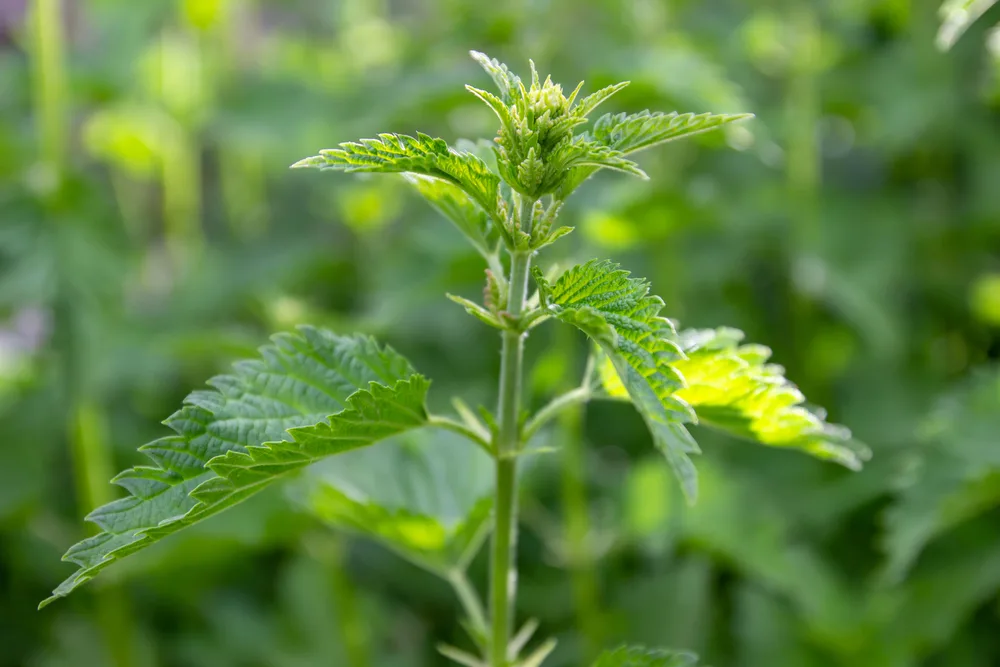
Look at the pointed, opposite leaves. Notice how they are coarsely toothed and bright green. Look closer, but not too close, to see the stinging hairs, called trichomes. To touch these are painful to say the least, but cooking and steaming will make the nettles completely edible, and incredibly tasty too!
Health benefits of stinging nettle
All parts of the stinging nettle are beneficial, and edible, in their own ways. From roots, to leaves and stems, all the way up to their flowers and seeds.
Nettles contain high amounts of silica and sulfur, and are rich in vitamins A, B2, C, D and K. They also contain generous amounts of iron and chlorophyll. All of these elements are essential for a robust immune system.
So, if you aren’t eating nettles already, I encourage you to try them in some of the recipes that are soon to follow.
You may be interested to know that, besides having an abundance of vitamins and minerals, there is some evidence to suggest that nettles are useful for treating common health problems such as hayfever and joint pain.
Nettle to treat seasonal allergies
With spring comes pollen, and a lot of it! It descends down from the trees as it rides the gentle breezes into your home and into your life. For many of us, spring is a time of sneezing, runny noses and itchy eyes.
To help treat seasonal allergies, it helps to drink a nettle infusion several times throughout the week, starting before your allergy symptoms appear.
For shiny, strong hair and bone health
Stinging nettle has both antihistamine and anti-inflammatory qualities. As such, it makes a wonderful treatment for eczema and rashes.
Nettle can be taken internally, in the form of powder or tea. It can also be applied directly to the skin via a handmade cream. First, however, you’ll want to turn that dried nettle into a powder. Find more on making your own nettle powder further down on the list.
For strengthening hair, our choice of herbal hair rinses switches between a tea made of walnut leaf, and that of nettle.
Herbal Hair Rinse – Nettle Leaf for Healthy Hair @ Pioneer Thinking
Nettles for arthritis and joint pain
If you have joint pain or arthritis, you may be seeking a natural remedy to manage your symptoms. Here is how stinging nettles help with arthritis pain.
To prevent kidney stones and urinary tract infections
Nettles are a gentle diuretic, that help the body to naturally flush toxins away. So, be cautious about drinking a cup, or two, right before bed! It is best to drink an infusion first thing in the morning, before your regular cup of coffee or tea.
Besides the health benefits listed above, there are several more. Nettle is beneficial for digestion, it may lower blood cholesterol levels, it is wonderful as a mouthwash (preventing gingivitis) and it is used in treatments of benign prostatic hyperplasia (BPH).
To find out more health benefits of nettle, this article provides a great overview: 12 Surprising Benefits of Nettle Tea You Should Know
Delicious ways to drink and eat stinging nettle
We don’t always choose a wild plant for the health benefits alone. Not at all. It must taste good too. Even better if it tastes amazing. Some of the best “wild” dishes contain nettle.
Once you learn how to locate and harvest it, your next camping trip will be that much richer. You can really impress your family and friends by fostering your foraging habit and learning how to forage for 24 more edible wild plants to harvest in early spring.
One can consider nettle as a pure survival food, others regard it as wild, nutrient-dense primal food that has limitless capabilities. How you choose to view it, and eat it, is your choice alone.
Gather some fresh nettle and let’s get cooking!
1. Nettle as a spinach substitute
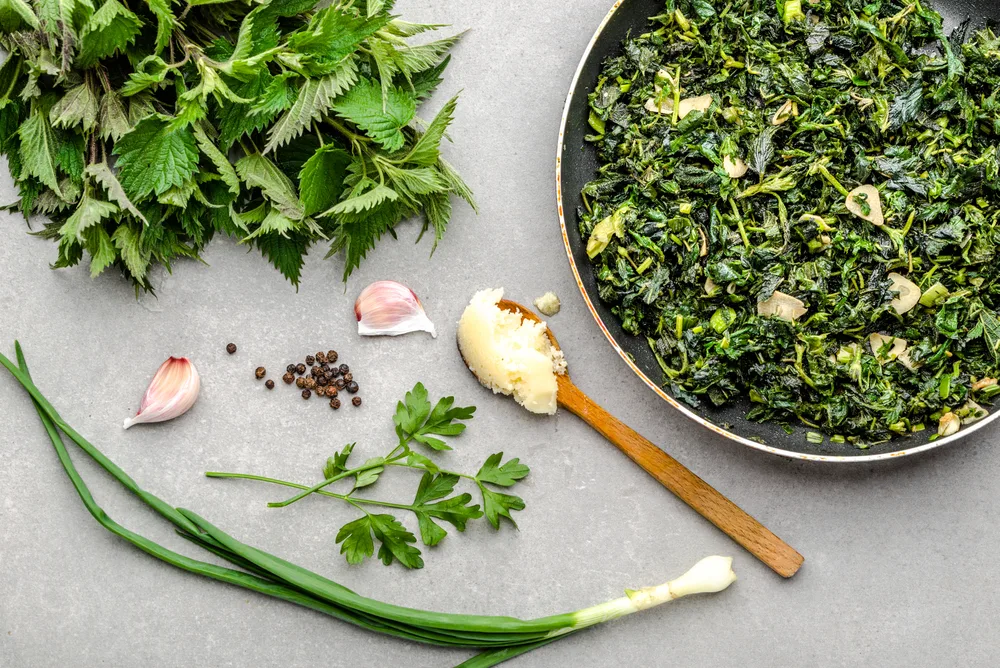
If you planted spinach seeds and somehow they never emerged, never fear, nettle is somewhere near.
You can replace spinach with nettles in all of your favorite recipes. Yet, I hear you questioning the flavor. Yes, it is slightly different, after all it is a wild green. Would I choose it over spinach? Yes. Every single day.
Nettles are your daily dose of vitamins that can be harvested for free. Sauté them in homemade butter, fry them with bacon bits, steam them and serve with mashed potatoes, or toss them in a quiche. Anything goes.
You might like to try out this nettle leaf and cheddar tart {gluten-free} while you are at it.
2. Stinging nettle pesto
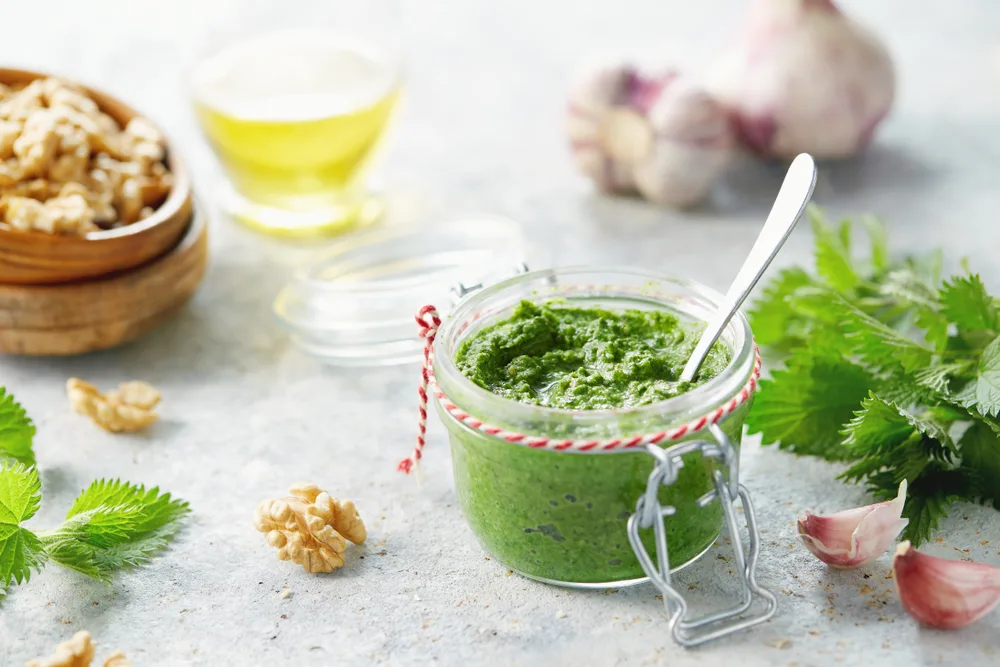
Just as you can make a mouthwatering pesto out of basil or wild garlic, so it can be done with stinging nettles too.
To make a nettle pesto you need to harvest a bunch (fill a basket or plastic bag), and blanch them first in a large pot of boiling water to take away the sting. In the end, you will need about 1/2 to 2/3 cup blanched, chopped nettles. Along with this you will need fresh garlic, pine nuts, salt, olive oil and grated cheese.
Start with this nettle pesto, then make your own modifications. Best is when you use the youngest nettle tops you can find.
3. Nettle soup
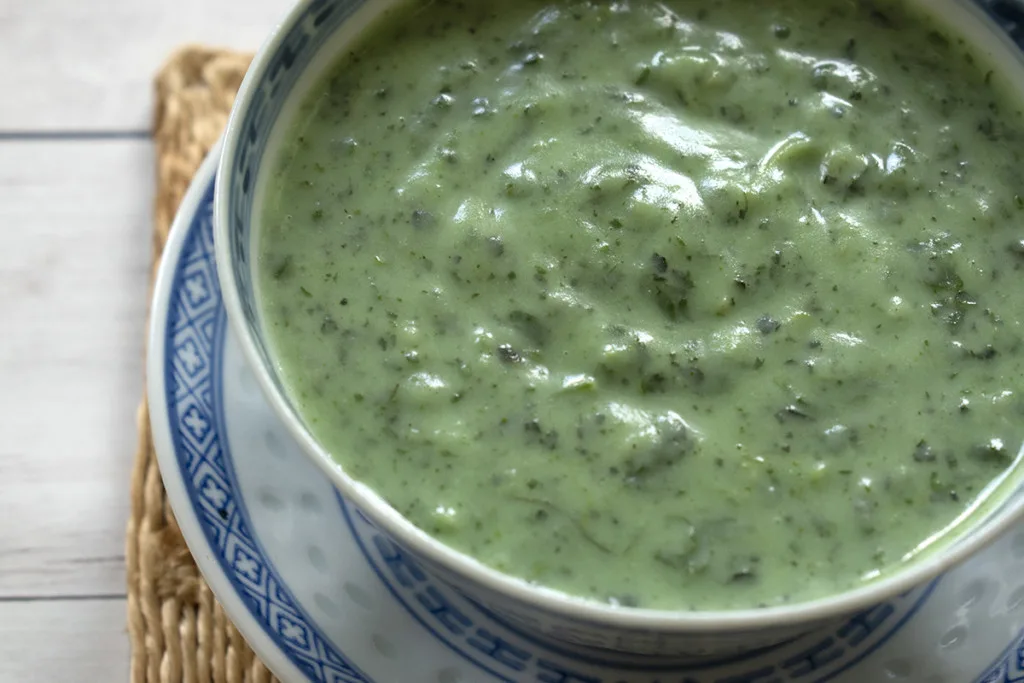
The tastiest nettles are harvested in spring, which can only mean that the nights still have a frosty chill about them. For a gardener, this can be a frustrating time – daytime temperatures lure you into the sunny garden, while the nighttime temps dip below zero…
Now is the season to let a nettle soup warm you up at the end of a long gardening day. It is simple to make and wonderful to eat.
You might also like to sample this version too:
Creamy Vegan Nettle Soup with Kale and Cauliflower @ Will Frolic for Food
4. Green smoothie
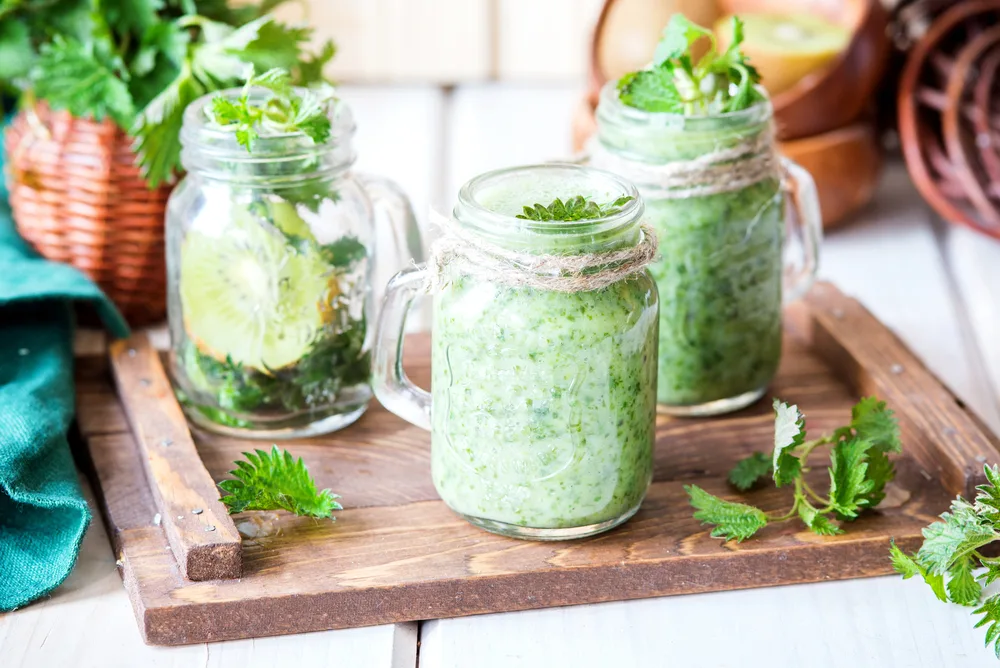
If you are experiencing spring fatigue and are seeking a natural cleanse for mind, body and spirit, quite often the herbs you seek are right under your nose, or rather, right under your feet.
Just like a bear emerging from slumber, after a long, cold winter, your body craves fresh greens to get it out of “sluggish” mode.
In our family we often overcome this spring fatigue by eating loads of ramsons, the first wild greens to shoot up where we live. Yet, the wild garlic harvest is so short-lived, that we must quickly move on to greener pastures.
Dandelions come next, right in line with stinging nettles and cleavers, just as the fruit trees are beginning to flower.
If detoxifying smoothies are “what’s for breakfast”, find inspiration in this green smoothie recipe. It is made with nettles, dandelion leaves, apples, bananas, avocado and an organic lime or lemon.
5. Nettle infusion
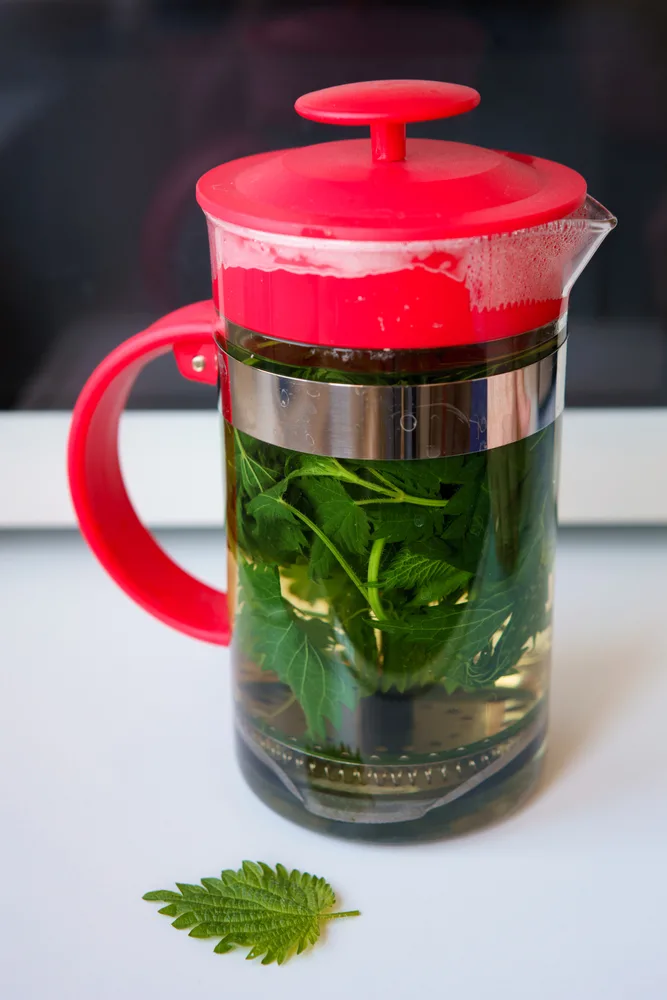
While nettle teas taste great and are amazingly good for you, herbal infusions are even better. The major difference are that infusions use more plant matter, and sit for a longer period of time.
In the case of a nettle infusion, you’ll want to use one ounce of nettle for every quart of water. You will also need to let it sit for a minimum of 4 hours, up to 12 hours overnight.
The end result is a rich herbal tonic, dark brown in color and intensely flavorful.
Unlike herbal teas which can be sipped throughout the day, it is wise to drink only 1 cup of nettle infusion per day. If you make a larger batch, you can store it in the fridge for an entire week.
In fact, cold nettle infusions are simply the best, with a squeeze of organic lemon and/or raw honey stirred in.
6. Nettles as an herbal rennet for cheesemaking
People have long been making cheese at home, far longer than commercial rennet became available. So, what did the cheesemakers use who came before you?
Well, rennet traditionally comes from animals. This is a specialized enzyme that can be taken from the stomach lining of young ruminants, such as baby goats, calves or sheep. If you don’t have any of those on hand, and not many of us do, there are rennets that can be derived from plants.
Thistles, sorrel, mallow, Lady’s bedstraw (Galium verum) and nettle are all wild vegetable rennets that can be foraged from nature.
If you are seeking to become more self-reliant in making cheese, why not try making your own rennet?
How to Make Nettle Rennet for Cheesemaking @ Cultures for Health
7. Dehydrated and ground into a powder
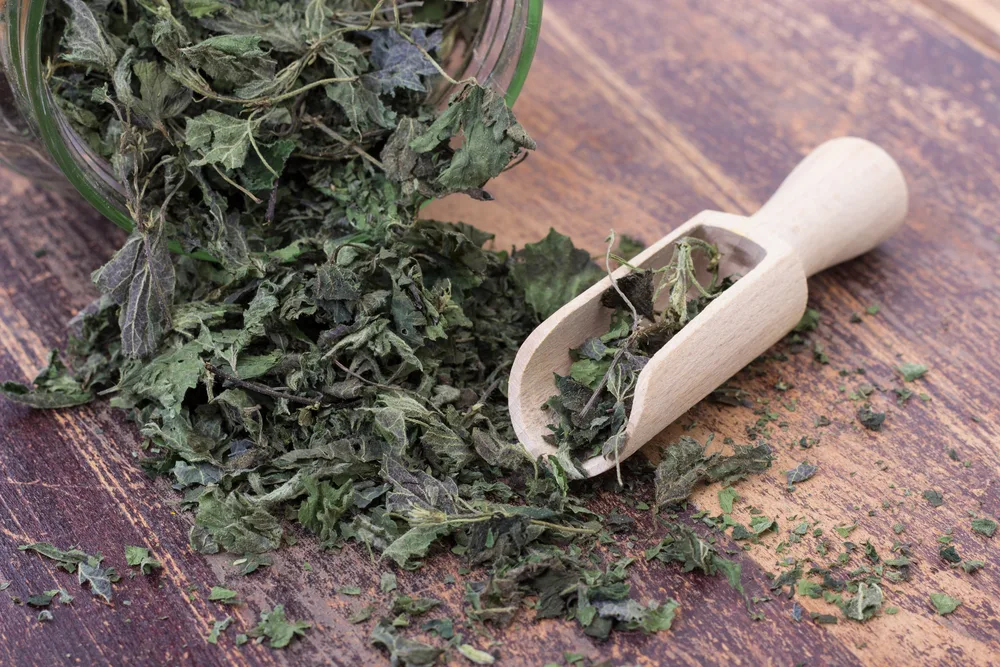
You can buy nettle powder online, or grind your own powder if you have a generous patch of nettles nearby.
The process of making nettle leaf powder at home, is simple.
- Collect nettle tops, or just the leaves, keeping in mind that once dehydrated, the powder makes up approximately 1/4 of the fresh harvest weight.
- Wash nettles and toss any undesirable leaves.
- Soak up excess water, setting the wet leaves between two tea towels.
- Dry the leaves on a tray, or in your dehydrator.
- Once the leaves are thoroughly dry and brittle, crush them by gloved hand and grind them in your favorite grinder.
- For a finer powder, sift them with a small sieve, then use a mortar and pestle to break them down further.
As your nettle powder is made by hand, you can grind it down to any consistency that you desire.
Then you can sprinkle it on top of your eggs, salads, even your morning latte.
8. Nettle tincture
If you suffer form seasonal allergies, you may want to quickly learn how to prepare your own herbal tinctures, for a tincture is one of the easiest ways to take your “allergy medication”.
For a nettle tincture you can use both the leaves and the roots.
A nettle tincture made from leaves is useful for treating hay fever symptoms, whereas a nettle root tincture is supporting men’s health.
Here’s our guide for making a plantain tincture which follows the same process as a nettle tincture.
Nettle as an eco-friendly material
Materials that are made by nature, not by mankind, are vital for a sustainable future.
This includes vegetable tanned (not chrome tanned) leather, just as much as it covers the production of colorgrown organic cotton, organic flax and hemp for fibers.
As previously mentioned, nettles have long been used as a durable fiber for spinning, though many of us have forgotten the ways of old.
The harvesting, retting, preparation of fibers, spinning and weaving of cloth by hand… It takes a lot of work to turn plant into cloth, but in a world of dangerous fast-fashion, it pays to take a peek back into the past and reexamine how they went about clothing themselves.
9. Stinging nettle as a fiber
It is one thing to process summer nettles for cordage, it is quite another to turn a bunch of poky stems into a lovable piece of handwoven cloth. My advice for you is to watch all the videos that are out there on the subject, and practice, practice, practice.
Spinning by hand, either with a spindle or spinning wheel, is such a pleasurable non-tech activity. It is even more rewarding when you have collected the fibers yourself.
If you are interested in finding out more on how to harvest, ret (to moisten or soak to soften and separate fibers by partial rotting) and spin nettle, one of the best resources to get started is Nettles for Textiles.
10. Nettle as a dye plant
Natural dyers know that walnut leaves make a luscious brown dye, woad and indigo make a magnificent blue, madder is red, but what does nettle do?
Nettle produces greyish minty tones to browny camouflage hues. As such, it is not a {synthetic} vibrant color to add to your wardrobe, though it is perfect for those items where you desire a subtle hue. Ideal for linens and tablecloths, undergarments too.
11. Nettle fertilizer for your garden
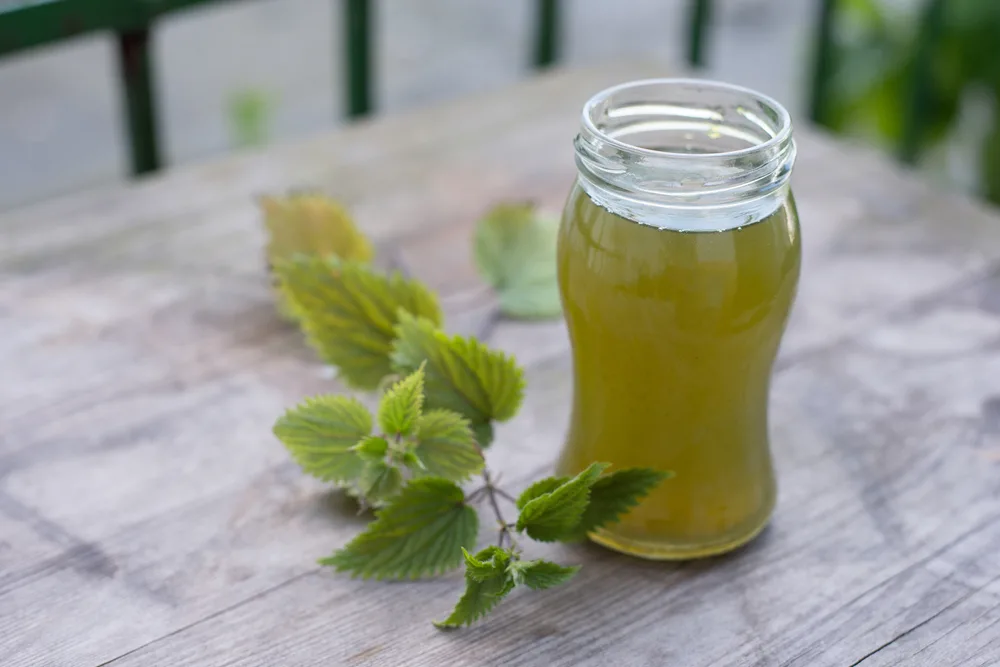
Stinging nettles are not only for human consumption, goats love wilted nettles too!
They are also of beneficial use in the garden, particularly for growing tomatoes, roses, legumes and other root vegetables.
If you have a patch of nettles that are beyond the joys of fresh eating, you can make a brew, or nettle manure, to use on your garden plants.
A tea can be made quickly in 24 hours, a manure might sit and brew for a few weeks, though it will be much more concentrated with higher levels of nitrogen, potassium and copper.
Apply it directly to the soil, or strain it and use it in a sprayer as an insect repellent for your green foliage.
10 Liquid Fertilizer Recipes from Weeds & Plants @ Rural Sprout
Tips for harvesting fresh nettle
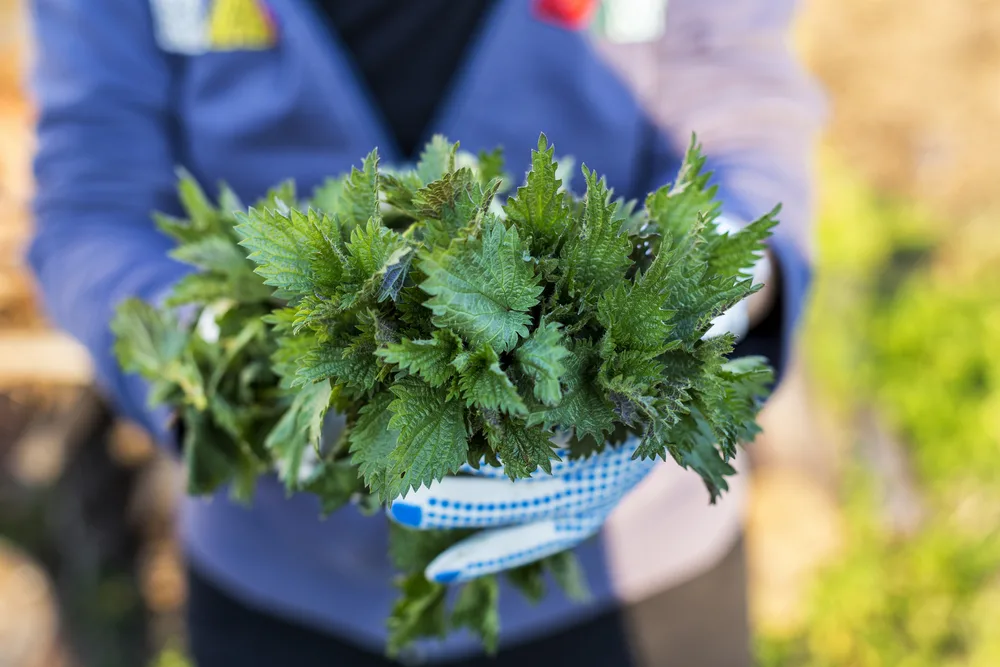
If you are about to cook and eat nettles fresh, the best time to harvest them is from late March through early May. This depends on your location, of course.
However, if they have already started to flower, it is best to harvest them only for drying and making herbal teas and infusions. In this case, you can harvest longer stems (up to 18″ is a good length for drying) and tie them carefully with a string. Let them air dry until they can be stored in a dark, dry place.
Let’s stick with the fresh nettle greens. Once you have identified a good-sized patch of young stinging nettles – one that is away from roadways and unsprayed by any chemicals – it is time to cut away.
For this you will need:
- a sturdy pair of leather gloves
- suitable clothing – long sleeves and thick pants (remember to cover your ankles!)
- pruners or kitchen shears
- bowl or basket for harvesting
If you are only after the tender leaves, save time by cutting them off directly from the stalk, right over your bowl or basket.
However, if you don’t mind the young stalks, say you are going to make nettle pesto in a blender, cut the nettle tops about 5-6″ in length.
As you are harvesting nettle, be sure to examine the undersides of the leaves. There could be spiders or other insect larvae present. Avoid those leaves and move on.
And of course, as with any time you are out foraging, do not overharvest!
Certain caterpillars love nettle! These include red admirals, peacocks and small tortoiseshell caterpillars. It is their food, as well as ours, share it with them.
If you do get stung by nettles…
You know the part that stings? Those jagged little hairs with pointed tips of pure silica? That is what gets stuck in your skin when you accidentally brush up against them. They contain formic acid and histamines that cause an immediate reaction on the surface of your skin.
It still happens on occasion to the most experienced nettle forager, the dreadful sting that lasts for several minutes, often causing a mild, red rash.
Even if you wear gloves, they may still brush up against your arms higher up, or lower on your legs if you are wearing shorts. And if you have ever stepped on nettles barefoot, trust me, I feel your pain!
On occasion it happens in the garden too, as you are pulling weeds (undesirable green growth) and a very small nettle bites into your fingers as a reminder to be more careful in the wild. What then?
How to stop a stinging nettle sting
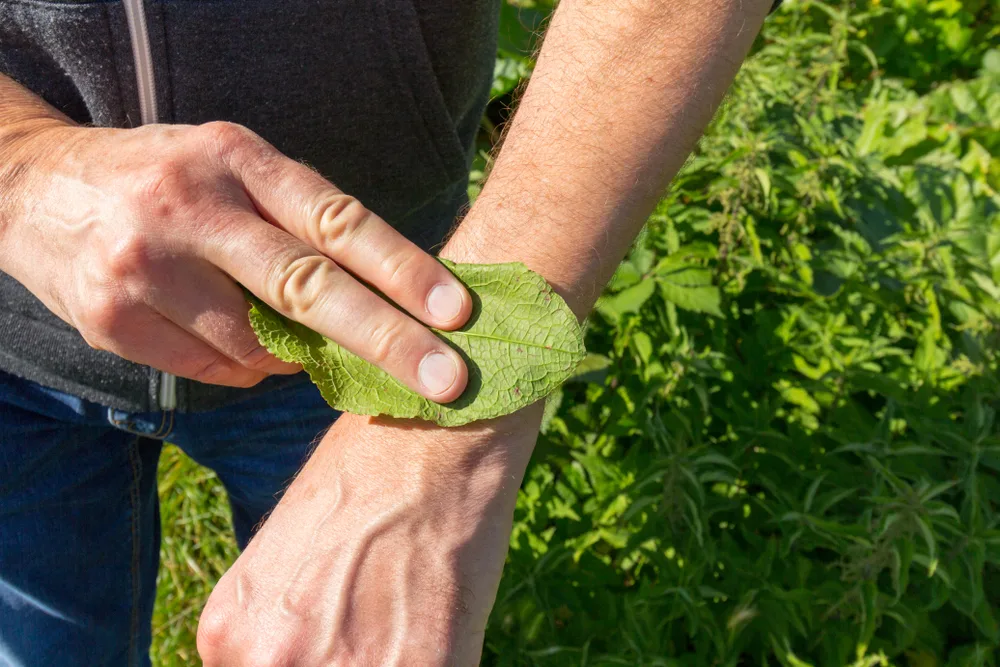
First of all, if you get stung by a nettle, don’t itch. Don’t scratch, don’t rub it or irritate it in any way. As with mosquito bites and rashes in general, this will only make it burn worse.
Many folk remedies proclaim that crushed dock leaves will take the pain away. And if you can find them nearby, it is certainly worth a try. Macerate them and use a poultice, as the moist sap from the leaves is thought to have a soothing, cooling effect on the skin. Let it sit for several minutes and see if it works.
If it doesn’t work, try washing your rash with diluted baking soda in water, or with a simple, natural non-fragrant soap.
The most important thing is to remove the nettle hairs.
With a magnifying glass you can often see those that are left behind, if you haven’t already felt where they are.
After that, go down the list until you find the best stinging nettle remedy that works for you:
- avoid heat from the sun and/or fire
- use cool or lukewarm water for showering/bathing, not hot water
- apply cold compresses for pain relief
- wear light clothes that do not rub on the irritated skin
- use an antihistamine, natural or over-the-counter if necessary
A rash from stinging nettle may last for up to 24 hours. Just be patient, relax and let it go away on its own.
Forgive it for your mistake and regain its trust again, by trying one of the non-stinging ways to use nettle above.
Don’t forget that nettles are perennials and a significant source of nutrition that is always available for free. If you happen to let some grow in your survival garden, you will have an early source of fresh, wholesome greens to complement your first harvests of both peas and lettuce.
To delve into more edible and medicinal plants that can easily be grown or foraged for in your backyard, start with this book and gather experience as you brew your own herbal teas:
Medicinal Herbs: A Beginner’s Guide: 33 Healing Herbs to Know, Grow, and Use by Rosemary Gladstar

Get the famous Rural Sprout newsletter delivered to your inbox.
Including Sunday musings from our editor, Tracey, as well as “What’s Up Wednesday” our roundup of what’s in season and new article updates and alerts.


